- Comparative study between CeO2 reinforced Zirconia Toughened Alumina (ZTA) and ZTA in terms of functional and mechanical properties
P. Ganeshana,*, Yaramala Sravania, K. Rajab and Bipin Kumar Singha
aCentre for Augmented Intelligence and Design, Department of Mechanical Engineering, Sri Eshwar College of Engineering, Coimbatore - 641202, Tamil Nadu, India
bDepartment of Mechanical Engineering, Anna University Regional Campus - Coimbatore, Coimbatore - 641046, Tamil Nadu, IndiaThis article is an open access article distributed under the terms of the Creative Commons Attribution Non-Commercial License (http://creativecommons.org/licenses/by-nc/4.0) which permits unrestricted non-commercial use, distribution, and reproduction in any medium, provided the original work is properly cited.
This investigation focused to develop 5 wt.% cerium oxide (CeO2) reinforced inside Zirconia Toughened Alumina (ZTA) ceramics for evaluation of functional properties which is still unexplored. At first, the homogeneous composites of CeO2/ZTA and ZTA are developed through powder metallurgy process sintered at 1600 oC. The morphological characterization of developed composites are carried out through field emission scanning electron microscopy (FESEM) and x-ray diffraction (XRD) followed by mechanical characterization on Vickers hardness tester. The morphological study reveals that the incorporation of CeO2 grains increases the average grain sizes of composites, adversely affect on the bulk density. The retention of high amount of metastable tetragonal phases due to presence of CeO2 grains evaluated through XRD phase analysis shows beneficial effect on hardness and fracture toughness. Furthermore, the significant improvement of 15.07% in fracture toughness is attributed to the transformation toughening, crack bridging and deflection phenomenon. Formation of glazy and smooth surface is responsible for improvement in coefficient of friction (COF) by 24.45% compared to parent matrix. High abrasion, micro cracks, grain pullout are predominant factors responsible for wear on the ZTA surface, whereas, grain pullout and micro cracks formation are responsible for wear in CeO2/ZTA
Keywords: Zirconia toughened alumina, Ceria, Mechanical properties, Functional properties
Prolong life and potential sustainability in harsh environment of alumina based ceramics are in huge demand by numerous of industries like aerospace, manufacturing, bio-sectors, automobile, tile, arts and many more. Among various alumina based ceramics Zirconia toughed alumina (ZTA) reinforced by rare earth metal i.e. cerium oxide (CeO2) attracting the scientific community due to exaggeration in transformations toughening phenomenon lead to high hardness and fracture toughness. The incursion of self-lubricating phenomenon [1] inside advanced ceramics exaggerated the functional properties to maximum through reinforcing solid lubricant. Hence, the augmentation of additives like YSZ [2] CeO2 [3] MoS2 [4] WC [5] MgO [6], CuO [7], Cr2O3 [8] not only improve the physical properties but also significantly affect the functional properties, indeed requirement of current industries. Among the several additives, the doping of CeO2 inside ZTA propounds significant effect on hardness and fracture toughness. In this context, Akin et al. [9] investigated the effect of CeO2 on the microstructure as well as physical properties of alumina and Alumina/YSZ composites densified through spark plasma sintering. Researchers showed favorable effect of YSZ in alumina whereas; adverse effect of ceria was observed on the physical properties due to formation of elongated CeAl11O18 grains. Zarinkamar et al. [10] developed a simple technique to synthesize the ceria particles using chloride salt through wet chemical method for its application in many ceramics as an additive. Temuujin et al. [11] selected Na2OCaO-Al2O3-SiO2 system (glass ceramics) for reinforcing the ceria particles to analyze its effect on crystallization behavior and mechanical properties. Researchers found that with addition of 0.5 wt.% ceria influences the crystallization towards formation of harder phases, consequences in the improvement of hardness by 15-20% than non cerium oxide. Ko et al. [12] used sol gel technique to develop Porous CeO2 - 20 wt.% TiO2 composite using titanium iso-propoxide and Ce(NO3)3·6H2O as precursors. The developed composites showed an excellent efficiency towards removal of phenol under UV light when calcined at 900 °C whereas; the powders calcined at 600 °C showed a strong edge band at the blue-green wavelength range. Rajeb et al. [13] used 0 wt.% to 15 wt.% ceria particles to see its effect on microstructure and mechanical properties for ZTA composites. Researchers found significant improvement in both said properties with 5 wt.% CeO2 additions, whereas; with higher percentage adverse effect was noticed. The maximum hardness was found as 1688 HV alongside the fracture toughness as 8.38 MPa.√m. The improvement was attributed to the lower apparent porosity, consequences of adding CeO2 in smaller quantity. Recently, Al‑Amin et al. [14] developed various composites of Alumina/ Zirconia toughened alumina doped with various percentages of ceria particles to evaluate its effect on mechanical properties. Researchers found that the ceria content of 5 wt.% sintered at 1500 °C had maximum hardness as 14.15 GPa whereas; the composites having ceria content of 15 wt.% had maximum fracture toughness as 12.03 MPa·m1/2. Researchers illustrated that the grain size developed after sintering, density, hardness of the constituents, and porosity were the main contributing factors on hardness of the composites, whereas; crack deflection and crack bridging were predominant phenomenon responsible for the improvement in fracture toughness.
The functional properties for nanoparticles ceria coated on Ti substrate using plasma electrolytic oxidation (PEO) were carried out by Aliofkhazraei et al. [15]. Concentration 25 gr/L showed lowest surface roughness that almost filled all the pores on the surface alongside significant improvement in wear rate i.e. 3.4 μg/N·m to 0.7 μg/N·m. The improvement is attributed to the embedding of hard ceria nanoparticle on the surface through coating. Later Atapour et al. [16] also selected ceria particles for coating on substrate AM50 magnesium alloy using aluminate-based PEO to investigate the wear properties. Researchers illustrated that at intermediate and high loads ceria particles significantly affect the wear rate that sustained for longer time. Di et al. [17] used micro-arc oxidation process for the coating of cerium oxide (CeO2) - doped TiO2 nanostructured on Titanium substrate. Researchers demonstrate that with increase in quantity of CeO2 through increasing the current density and electrolyte concentration results in lesser pores with bigger holes had smooth surface surrounding the micro-holes alongside minimum surface roughness. The hardness of surface was achieved as 609.17 Hv at 4 g/L the CeO2 concentration. Kumar et al. [18] studied the tribological behavior of CeO2 in Al2O3 coated on AZ91 alloy. Researchers found significant behavior of CeO2 doped coatings towards achieving low COF attributed to refinement of coating microstructure and strengthening the substrate-coating interface by suppression of M-O phase. Furthermore, the earlier investigations carried out by researchers [19-22] suggested huge potential of alumina ceramics in structural application and noticed as futuristic materials
Hence, the beneficial effect of CeO2 on the mechanical & functional properties through coating was illustrated by various researchers but no research is dedicated towards evaluation of CeO2 as an additive inside ZTA matrix to enhance the functional properties like COF & specific wear (novel aspect). Furthermore, the phenomenon aligned to improve the functional properties is yet limited, inconclusive and need more exploration. So, in this works authors selected the optimum quantity of CeO2 (based on earlier work) in terms of mechanical properties to reinforce inside ZTA for analyzing the functional properties. Therefore, at first, homogeneous CeO2/ZTA ceramics are developed using powder metallurgy route followed by morphological and mechanical characterization. After characterization a comparative study in terms of functional properties like COF & specific wear are evaluated. Finally, a conclusive remark with all possible phenomenons has been postulated using FESEM images of wear track.
Synthesis of CeO2/ZTA composites:
In this investigation, the ZTA powders are developed through Co-precipitation route followed by physical mixing with ceria particles to develop CeO2/ZTA composites. The selection of compositions of ZTA i.e. 90 wt.% alumina and 10 wt.% yttria stabilized zirconia is based on earlier work of researcher [23] that govern maximum mechanical properties. The preparation of ZTA composites starts with measuring requisite amount of zirconyl and alumina nitrate salt i.e. [ZrO(NO3)2·5H2O] and Al(NO3)3·6H2O (> 99%, BDH, India) along with yttrium nitrate hexahydrate [Y(NO3)3·6H2O] (Aldrich). The chemical have 99% purity, mixed in distilled water to prepare the solution. The solution was further treated with 0.1 mol% ammonia solution through burette for drop wise mixing. A temperature of 70 °C was maintained till the pH of solution not reached to ≈ 9, in order to complete the formation of gelatinous precipitate. The precipitate was left for 12 h followed by removal of water in a filter unit. During filtration the precipitate was continuously washed with warm water to remove all nitrate ions. The nitrate free precipitate was kept in an oven for 24 h followed by manual crushing process. The crushed ZTA powders were decomposed at 800 °C to remove all impurities. The calcined powders of ZTA were further mixed with 5 wt.% CeO2 in order to develop CeO2/ZTA composite based on earlier work that has highest mechanical properties [24]. The mixing of CeO2 starts with sonication in methanol medium on sonicator. The dispersed CeO2 particles were kept in zirconia jar consisting of requisite amount of ZTA powder along with different size of alumina ball in 1:3 (powder: alumina) ratio. The filled zirconia jar was placed inside planetary ball mill for milling at rotational speed of 300 rpm for next 24 h. The perfectly milled powder was again mixed with automatic mixer with 0.8 wt.% polyethylene glycol 1000 act as a plasticizing agent for next 6 h. The perfectly blend mixture was dried in an oven at 100 °C and crushed on mortar pastel. The milled powders were again calcined at 800 °C.
Procedure to characterize mechanical and functional properties
The fined milled powders of developed 5 wt.% CeO2/ZTA was measured in requisite amount to pour in a square shape steel die. The die was placed on hydraulic press to compact the powders in two steps. In first step a pressure of 5 ton cm-2 was applied for 1 min followed second step by applying 10 ton cm-2 pressure for next 1 min. The green compacted samples having size 12 × 12 × 8 (L × B × H) mm were slowly removed with help of ejecting punch decomposed at a temperature of 1600 °C for 2 h. The sintered samples were used for morphological studies like FESEM and XRD analysis. The FESEM images were taken at same magnification whereas; detector-angle range (2θ) kept between 10° and 70o for XRD analysis. Furthermore, the XRD peaks were used to determine the zirconia phases like monoclinic and tetragonal present inside the cluster using equation (1) & (2).

Xm is intensity of m-ZrO2 w.r.t. the total ZrO2, Im is intensity of monoclininc zirconia phase and It is intensity of tetragonal zirconia phase, Vm is monoclinic volume fraction.
After morphological studies the samples were thoroughly polished till surface roughness was reached to 0.5 micron. During polishing honing/lapping method was opted with several mesh sizes of silicon carbide followed by diamond paste polishing on Bain polisher. After polishing the samples were sonicated to remove all foreign particles embedded on the surface and decomposed at 800 °C to relieve the stress developed during polishing. Archimedes principal has been opted to evaluate the bulk density alongside rule of mixing was implemented to evaluate the theoretical density. The ratio of bulk density and theoretical density provide relative density that justifies the level of densification. Furthermore, the mirror polished samples were used to evaluate the hardness as well as indentation fracture toughness on Vickers hardness testing machine. The process and calculation involved during evaluation are explained in author’s earlier work [25]. For every data an average of 10 readings were considered (holding time of 10 Sec.) to analyse the effect.
After thorough investigation of mechanical properties, the functional properties were evaluated on universal Mechanical Tester (UMT-2, Bruker, USA) in terms of co-efficient of friction (COF) and Specific wear rate. The detail process to evaluate the COF and specific wear is illustrated in earlier work of author [26]. Corundum alumina balls having 6 mm diameter was used as counter surface. A load of 10 N and sliding velocity of 4 mm/sec was selected to illustrate a comparative study between CeO2/ZTA and ZTA. The parameters were selected based on earlier work of Piyush et al. [27]. The agile phenomenons were studied through FESEM images of worn track. The specific wear rate for each experiment was determined after completion using equation (3), (4) and (5). Scar diameter was measured through optical microscope. An average of five reading all around the diameter was taken to illustrate the scar diameter.
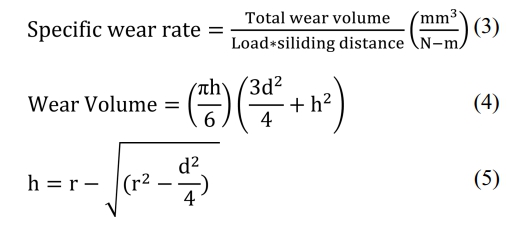
Where d is the scar diameter, r is the radius of alumina ball.
Morphological characterization
A homogeneous structure of developed composites is observed through FESEM images illustrated in Figure 1. From structural images it can be propounded that the average grain sizes are increases with incorporation of ceria particles after sintering, similar findings were earlier reported by [9, 13]. The earlier studies suggested that the grain growth during sintering is entire phenomenon of pore mobility rate or pinning effect [29].
Researchers suggested that the grain boundaries mobility is affected by Pore-drag through pinning pressure restricting the mobility of grain boundary consequences in grain growth inhabitation. But adverse effect of CeO2 is observed may be due to high mobility of grain boundary i.e. driving pressure is larger than drag pressure consequences in high grain growth during sintering. Furthermore, the formation of elongated grains i.e. CeAl11O18 (Ce2O3·11Al2O3) due to porn oxidation behavior of CeO2 particles result in higher grain sizes. Hence, it can be concluded that the presence of CeO2 particles created adverse effect on the grain sizes that reflected on the mechanical properties.
The phase characteristics of CeO2 (5 wt.%) doped ZTA alongside the reference matrix using XRD analysis is illustrated in Fig. 2. JCPDS data sheet is used to identify the peaks developed after sintering, which is systematically represented in the XRD plots. The important phases like tetragonal zirconia (t-ZrO2) and monoclinic phases (m-ZrO2) are calculated using XRD peaks to see the translational effect occurred due to presence of ceria particles. The evaluated values of tetragonal and monoclinic phases of zirconia are summarized in Table 1.
From XRD analysis and phase calculation, the earlier concept i.e. ceria particles act as a stabilizer for tetragonal phase of zirconia are strongly defended. The phase analysis revealed that the monoclinic phases are decreases and tetragonal phases are increases with incorporation of ceria particles. It happened due to similar ionic radius posses by Ce4+ and Y3+(Ce4+: 0.96 Ǻ and Y3+: 0.92 Ǻ) [14] particles result in the stabilization of metastable zirconia phase by forming solid solution with (Zr,Y)O2 phases. Hence, an increment of 56.75% is noticed through phase calculation for tetragonal phases of zirconia; results are in accord with Rejab et al. [13] and Tsukuma [29]. Furthermore, Tsukuma revealed that the retention of metastable zirconia phases consequences in the improvement of fracture strength due to high thermal stability, accompanied in transformation toughening phenomenon. So, it can be concluded that the ceria particles have favorable effect on the retention of meatastable zirconia phases inside the cluster at room temperature.
Mechanical Characterization of Sintered Samples
Table 1 also summarized the mechanical properties of developed composites in terms of bulk density, hardness and fracture toughness. From analysis an improvement of 15.07% in fracture toughness whereas, decrement of 6.65% in bulk density, is observed with compare to parent matrix. The decrement in bulk density is attributed to the exaggeration in gain sizes, favorably enhances the porosity inside the matrix result in decrement of bulk density. Furthermore, an effect of transformation toughening phenomenon, exaggerated by retention of metastable tetragonal phases slightly improve the hardness of the CeO2 doped ZTA composites, contradicting the behavior of larger grains. The results are in agreement with the Rajeb et al. [13]. Researchers demonstrated that the shape, size and amount of pores inside the cluster have huge impact on the reduction of strength at the cross-sectional areas, also diminishes the capacity of load over the surface. Hence, the formation of elongated grains i.e. CeAl11O18 (Ce2O3·11Al2O3) exaggerated the presence of pores inside the cluster result in lowering the bulk density. Furthermore, the phenomenon of transformation toughening mechanism reveals that the volume of tetragonal phases retained inside the cluster transformed into monoclinic phases at a threshold stress consequences in expansion of volume by ~3-4% [30, 31]. Researchers observed that the vicinity of propagating crack inside the cluster is highly influenced by the zirconia particle due to stress-induced effect govern by metastable phase. At room temperature the monoclinic phases of zirconia exist, which transformed into tetragonal phases when heated beyond 1170 °C and vice versa. So, during sintering the monoclinic phases are transformed into the tetragonal phases which again transformed to monoclinic after removal of heat, but certain amounts of tetragonal phases remain trapped at room temperature due to presence of neighboring element like ceria, yttria etc. The retention of tetragonal phases is known as metastable phases of zirconia. The presence of these particles creates compressive stress during propagation of crack consequences as the barrier for further crack growth. Furthermore, the said phenomenon govern by ZrO2 grains influences intergranular and intragranular particles creates an obstacle for plastic deformation and increases the intermolecular bonding consequences in high hardness.
The presence of ceria particles provides an interesting effect on the fracture toughness i.e. it significantly improves. The earlier studies revealed that the improvement in fracture toughness was attributed to the transformation toughing, crack bridging and crack deflection phenomenon. The entire three phenomenons are predominantly observed in case of ceria added ZTA matrix. The contribution of crack bridging and crack deflection phenomenon towards improvement in fracture toughness was thoroughly explained by Singh et al. [32]. From XRD spectra it is also observed that the retention of metastable tetragonal zirconia enhanced with presence of ceria grains inside the composites. The trapping of t→m transformation (metastable t-zirconia to m-zirconia) increases compressive stress attributed to the volume expansion around 3%-4% at the tip of crack propagation which requires high energy for further propagation. The requirement of higher energy or restriction of propagation of crack growth results in high value of fracture toughness.
Furthermore, in ceramics the path followed by the cracks is intergranular or transgranular way that associated with the grain boundary energy where pores play a vital role. The structures having abnormal grain growth represents heterogeneous microstructures that forced to propagate the crack in transgranular way where the larger pores creates additional work to complete fracture. Furthermore, the presence of high porosity or ductility through reinforcing elements significantly affects the plastic dissipation of metal ligaments. The plastic dissipation produces acoustic waves inside the cluster also relieving some stress that require higher local residual stresses towards propagation of crack inside the cluster, replicated in higher fracture toughness value [33, 34]. Hence, the combination of transformation toughing, crack bridging and deflection phenomenon provides higher value of fracture toughness.
Functional Characterization of Sintered Samples (Mirror polished ~0.5 micron)
Fine polished, stress relieved i.e. calcined at 800 oC samples are selected to carry out the tribological test at load of 10 N and sliding velocity of 4 mm/sec. The comparative results in terms of coefficient of friction (COF) are shown in Fig. 3.
The result showed significant improvement in COF i.e. 24.45% w.r.t. parent matrix. The phenomenons beneficial towards improvement of COF are analyzed through FESEM images of wear track shown in Fig. 4(a) and (b). The astral analysis of the wear track clearly showed that the CeO2 doped ZTA have glazy and smooth surfaces compare to ZTA surface on wear track after tribological test. This happened due to presence of high elongated or ductile grains i.e. CeAl11O18 (Ce2O3·11Al2O3) inside the cluster that easily deformed result in smooth and glazy surface, accountable for improvement in COF.
Furthermore, the wear analysis of both surface revealed that the ZTA surface has high abrasion, micro cracks, grain pullout. The results are in accordance with earlier cited results [26, 27] for ceramics materials doped with CuO particles. In addition, the grain pullout and presence of micro crack in larger amount are responsible for wear in case of CeO2/ZTA, whereas abrasion phenomenon is rarely observed. The presence of high porosity that adversely affects the strength of CeO2/ZTA composite is responsible for high specific wear rate. The evaluated values of specific wear rate also justified the said results. Higher diameter of scar diameter is observed on the counter surface in case of CeO2/ZTA, replicated in high specific wear rate. The picture of scar diameter alongside the evaluated values of specific wear rate is shown in Fig. 5(a, b) and Fig. 6(a, b).

|
Fig. 1 (a) FESEM images of ZTA (b) FESEM image of 5 wt.% CeO2/ZTA. |
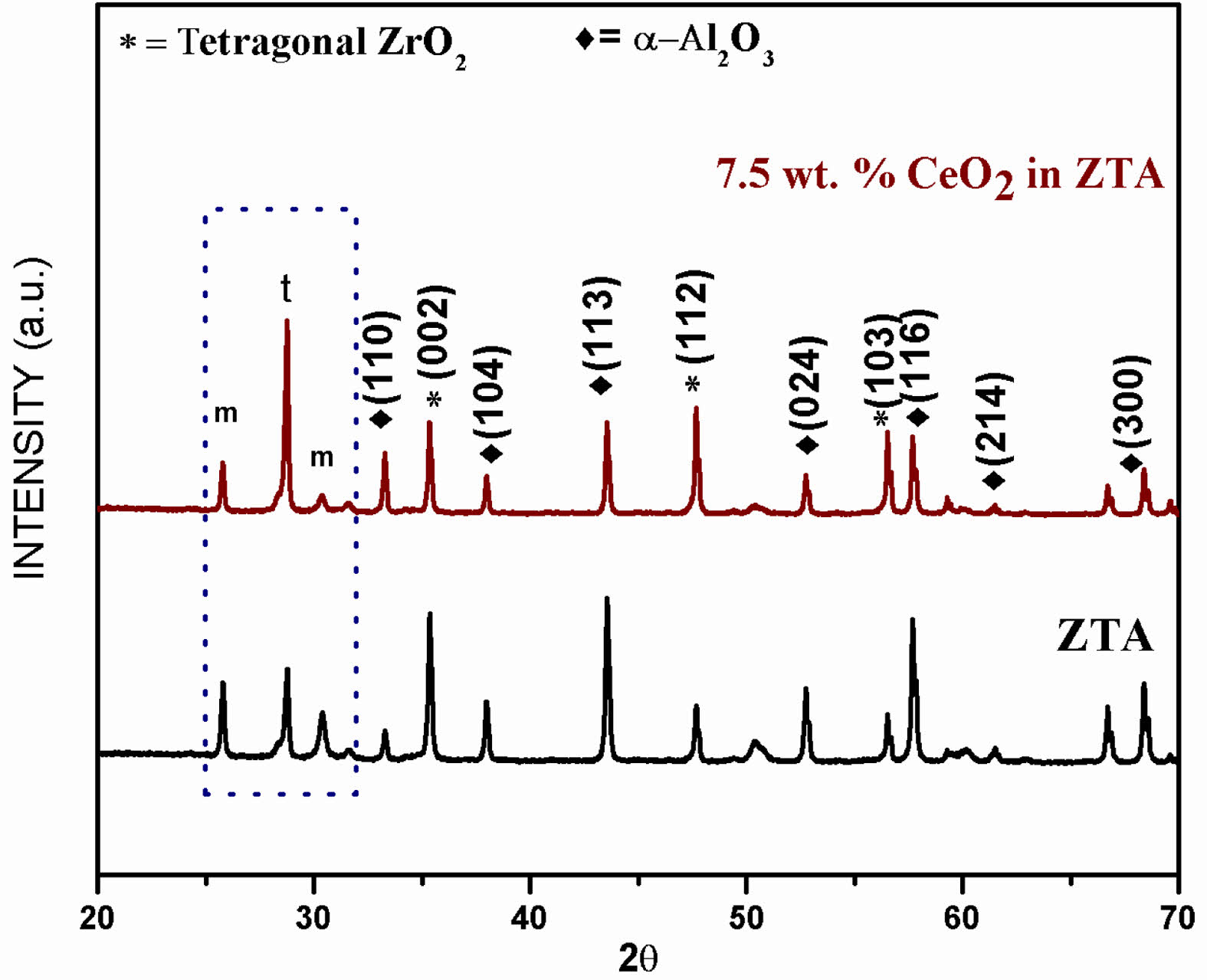
|
Fig. 2 XRD of ZTA and 7.5 wt.% CeO2/ZTA. |
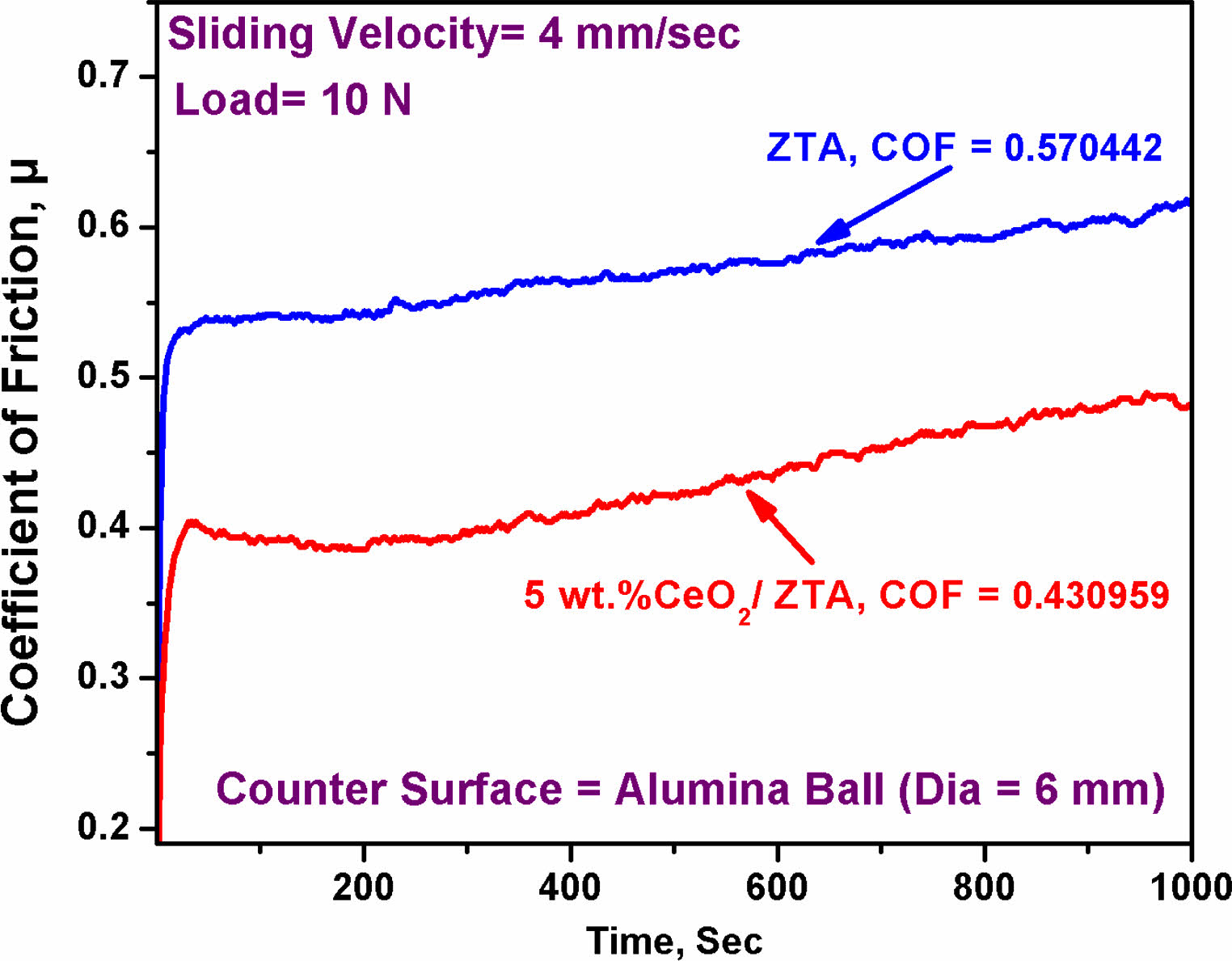
|
Fig. 3 Coefficient of friction for ZTA and 5 wt.% CeO2/ZTA. |

|
Fig. 4 (a) Wear track FESEM images of ZTA (b) Wear track FESEM images of 5 wt.% CeO2/ZTA. |
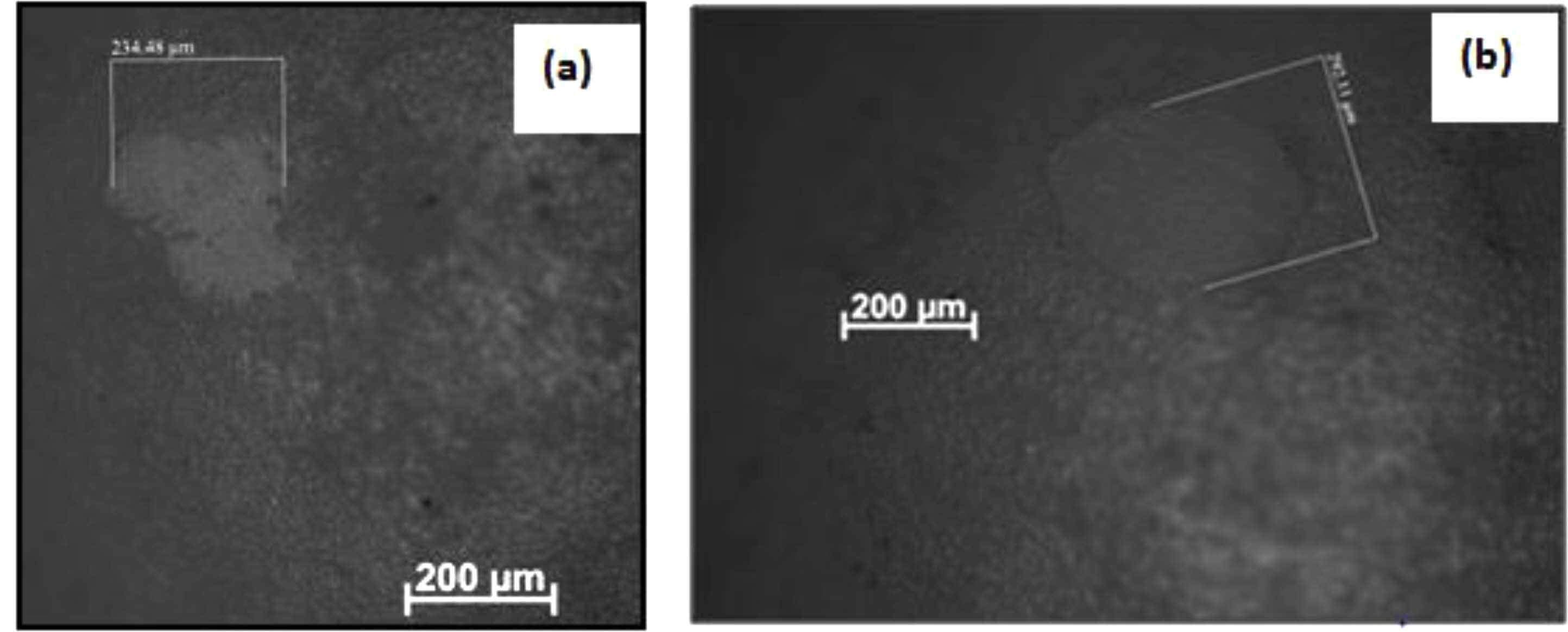
|
Fig. 5 (a) Scar diameter on counter surface of ZTA (b) Scar diameter on counter surface of CeO2/ZTA. |
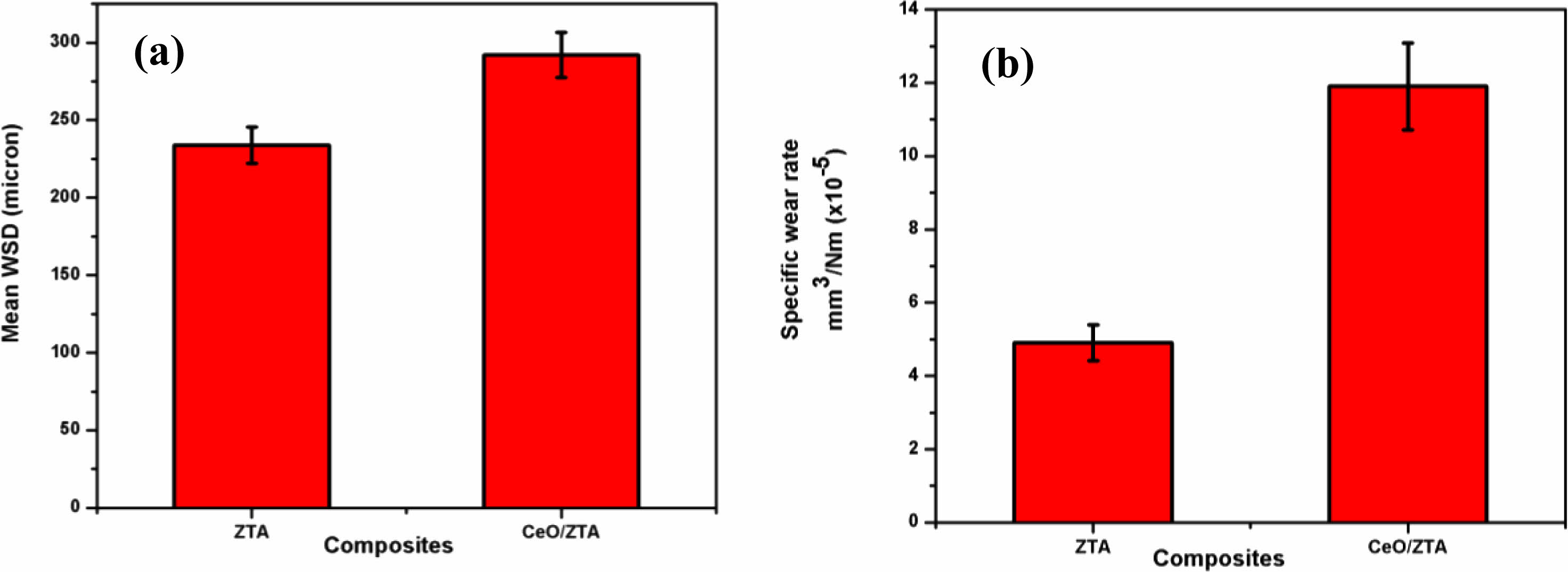
|
Fig. 6 (a) Evaluated values of Mean scar diameter on (b) Evaluated values of Specific wear rat |
|
Table 1 Morphological & Mechanical Properties of Samples (Sintered at 1600 oC). |

Homogeneous composites of 5 wt.% cerium oxide (CeO2) reinforced inside Zirconia Toughened Alumina (ZTA) along with ZTA ceramics are synthesize to evaluate the functional and mechanical properties. Morphological study revealed that the average grain sizes are increase with incorporation of ceria particles. The replicated effect of grain size is observed on the bulk density. Furthermore, transformation toughening phenomenon is responsible for slight improvement in hardness of CeO2/ZTA composites. A significant improvement i.e. 15.07% in fracture toughness is attributed to the transformation toughening, crack bridging and deflection phenomenon. The analyses of function properties reveal that the formation of glazy and smooth surface significantly decreases the value of coefficient of friction (COF) by 24.45% for CeO2/ZTA. The wear phenomenon predominate in ZTA composites are abrasion, micro cracks, grain pullout whereas, grain pullout and micro cracks are responsible phenomenon for wear in CeO2/ZTA.
The author thanks the Principal and Director of Sri Eshwar college of Engineering for their continual support to write this article.
Fund received by DST-INDIA-FIST Program-2022 [TPN-83971] (SR/FST/College-/2022/1300).
No conflict among the authors.
All data are presented in the manuscript.
- 1. B.K. Singh, Trans. Indian Ceram. Soc. 82[1] (2023) 1-13.
-

- 2. N. Mandal, B. Doloi, B. Mondal, and B.K. Singh, Proc. Inst. Mech. Eng. B J. Eng. Manuf. P. 231[8] (2015) 1396-1408.
-

- 3. B. Mondal, N. Mandal, and B. Doloi, Int. J. Appl. Ceram. Tec. 11 (2014) 228-239.
-

- 4. K. Ghosh, S. Mazumder, B.K. Singh, H. Hirani, P. Roy, and N. Mandal, J. Tribol. 142[2] (2020) 021704.
-

- 5. S.L. Casto, E.L. Valvo, E. Lucchinib, S. Maschiod, M. Piacentinia, and V.F. Ruisia, Wear (1999) 227-233.
-

- 6. B.K. Singh, H. Roy, B. Mondal, S.S. Roy, and N. Mandal, Mach. Sci. Technol. 22[6] (2018) 899-913.
-

- 7. B.K. Singh, A.A.Yaduvanshi, and A.K. Mishra, (2022). In: Mukherjee, K., Layek, R.K., De, D. (eds) Tailored Functional Materials. Springer Proceedings in Materials, vol 15. Springer, Singapore.
-

- 8. B.K. Singh, B. Mondal, and N. Mandal, Ceram. Int. 42 (2016) 3338-3350.
-

- 9. I. Akin, E. Yilmaz, F. Sahin, O. Yucel, and G. Goller, Ceram. Int. 37[8] (2011) 3273-3280.
-

- 10. M. Zarinkamar, M. Farahmandjou, and T.P. Firoozabadi, J. Ceram. Process. Res. 17[3] (2016) 166-169.
-

- 11. J. Temuujin, U. Bayarzul, E. Surenjav, D.S. Kim, and Y.S. Chu, J. Ceram. Process. Res. 18 (2017) 112-115.
-

- 12. J.B. Ko, S.M. Choi, I.C. Kang, and J.K. Han, J. Ceram. Process. Res. 11[1] (2010) 123-125.
-

- 13. N.A. Rejab, A.Z.A. Azhar, M.M. Ratnam, and Z.A. Ahmad, Int. J. Refract. Met. Hard Mater. 36 (2013) 162-166.
-

- 14. M., Al-Amin, H.T. Mumu, S. Sarker, M.Z. Alam, and M.A. Gafur, J. Korean Ceram. Soc. 60[1] (2023) 141-154.
-

- 15. M. Aliofkhazraei, G.R. Shoja, M. Teimouri, M. Ahmadzadeh, D.G. Barati, and H. Hasannejad, J. Alloys Compd. 685(2016) 376-383.
-

- 16. M. Atapour, C. Blawert, and M.L. Zheludkevich, Surf. Coat. Technol. 357 (2018) 626-637.
-

- 17. S. Di, Y. Guo, H. Lv, J. Yu, and Z. Li, Ceram. Int. 41[5] (2015) 6178-6186.
-

- 18. S. Kumar and D. Kumar, Surf. Coat. Technol. 349 (2018) 462-469.
-

- 19. N. Canikoglu, J. Ceram. Process. Res. 22[3] (2021) 258-263.
-

- 20. S. Pazarlioğlu and S. Salman J. Ceram. Process. Res. 20[1] (2019) 99-112.
-

- 21. B. Kima, S. Jeona, C.J.V. Tyneb, H. Parkc, and H. Leea, J. Ceram. Process. Res. 17[5] (2016) 459-463.
-

- 22. M. Shahida, R. A. Malika, H. Alrobeib, J. Kimc, M. Latifc, A. Hussaina, M.U. Iqbala, and A. Hafizb, J. Ceram. Process. Res. 22[2] (2021) 149-157.
-

- 23. B.K. Singh, K. Ghosh, S.S. Roy, B. Mondal, and N. Mandal, Trans. Indian Ceram. Soc. 77[4] (2018) 219-225.
-

- 24. B.K. Singh, N.C. Adaka, S.S. Royb, S.S. Chakrabortya, and N. Mandala, Evaluation of Metallurgical and Mechanical Properties of CeO-Reinforced Zirconia Toughened Alumina. Dr. Samik Dutta Dr. Shitanshu Shekhar Chakraborty, p.52.
- 25. A. Pratap, P. Kumar, N. Mandal, and B.K. Singh, Mater. Today: Proc. 26 (2020) 2442-2446.
-

- 26. B.K. Singh, S. Samanta, S.S. Roy, R.R. Sahoo, H. Roy, and N. Mandal, Mater. Res. Express 6[12] (2020)125208.
-

- 27. P. Kumar, A. Pratap, N. Mandal, and B.K. Singh, Mater. Today: Proc. 44 (2021) 1806-1810.
-

- 28. N.A. Rawashdeh, W. Khraisat, and H. Borgström, Jordan J. Mech. Ind. Eng. 11[2] (2017) 67-71.
- 29. X.K. Tsukuma, Am. Ceram. Soc. Bull. 65[10] (1986) 1386-1389.
- 30. B.K. Singh, H. Roy, B. Mondal, S.S. Roy, and N. Mandal, Measurement 142 (2019) 181-194.
-

- 31. B.K. Singh, S. Goswami, K. Ghosh, H. Roy, and N. Mandal, Int. J. Refract. Met. Hard Mater. 98 (2021) 105551.
-

- 32. A. Pratap, B.K. Singh, and N. Sardana, Mater. Today: Proc. 66 (2022) 3738-3742.
-

- 33. K. Raja, P. Ganeshan, B.K. Singh, R.K. Upadhyay, P. Ramshankar, and V. Mohanavel, Sādhanā 48(2) (2023) 72.
-

- 34. B. Vinith, S.D. Dharshan, S. Aravind, B. K. Singh, and S.G. Kumar, Mater. Today: Proc. (2023).
-

 This Article
This Article
-
2023; 24(5): 781-787
Published on Oct 31, 2023
- 10.36410/jcpr.2023.24.5.781
- Received on Apr 29, 2023
- Revised on Aug 13, 2023
- Accepted on Aug 29, 2023
 Services
Services
- Abstract
introduction
preparation of samples & experimental process
result and discussion
conclusion
- Acknowledgements
- Funding
- Conflict of Interest
- Availability of data and materials
- References
- Full Text PDF
Shared
 Correspondence to
Correspondence to
- P. Ganeshan
-
Centre for Augmented Intelligence and Design, Department of Mechanical Engineering, Sri Eshwar College of Engineering, Coimbatore - 641202, Tamil Nadu, India
Tel : +91 8124929100 - E-mail: ganeshram84@gmail.com






 Copyright 2019 International Orgranization for Ceramic Processing. All rights reserved.
Copyright 2019 International Orgranization for Ceramic Processing. All rights reserved.